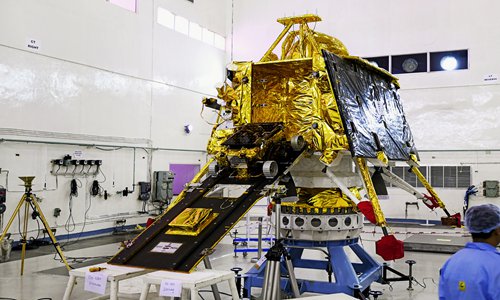HOME >> CHINA
Chinese netizens encourage India’s lunar dream despite failure
By Wang Qi Source:Global Times Published: 2019/9/8 16:22:25

Indian Space Research Organisation (ISRO) scientists work on the orbiter vehicle of 'Chandrayaan-2', India's second moon mission planned and developed by the ISRO, in Bangalore, India, 27 June 2019. Photo: IC
Chinese net users tipped their hats to Indian space scientists and encouraged them to continue to explore the universe after the country's second moon mission lost communication with the ground station.
The country's moon lander was expected to make a soft-touchdown near the moon's South Pole on Saturday but diverged from the planned path less than 2.1 kilometers above the lunar surface and lost its communications with the mission control room.
After the news was disclosed on China's Twitter-like Sina Weibo, Chinese netizens encouraged Indian scientists to not lose hope.
"Space exploration is being chased by all human beings. No matter which country has made a breakthrough, it deserves our praise, and those who have temporarily failed also deserve our encouragement," said a net user.
Indian scientists have made great efforts and sacrifices for space exploration. Keyboard warriors should stop laughing at those heroes, another user said.
"We are all in the gutter, but some of us are looking at the stars. Any nations that bravely strive to further explore space deserve our respect," said a user on China's Quora-like Zhihu.
Despite the loss of communication with the lander, the Indian Space Research Organization (ISRO) said that 90 to 95 percent of the mission's objectives have been accomplished and will continue to make contributions to lunar science, the Xinhua News Agency reported.
The loss of connection was very likely due to the failure of attitude control thrusters (ACT), which caused the lander to lose control, Pang Zhihao, a Beijing-based expert in space exploration technology, told the Global Times on Sunday.
According to Pang, the lander was only equipped with eight ACTs of 50-newton which provides no way to remedy the failure. China's Chang'e-3 lunar probe is outfitted with 28 ACTs.
The five 800-newton liquid-fueled main engines of the lander are also believed to be not enough for a descent and landing. According to Pang, China's solution is a huge variable thrust engine with 1,500 to 7,500 Newton of power.
According to Xinhua, the mission was aimed at studying the moon's exosphere, surface and sub-surface. The failure also delayed India from entering the elite club of moon-landing with the US, China and Russia.
Newspaper headline: Chinese netizens encourage India’s lunar dream
Posted in: SOCIETY